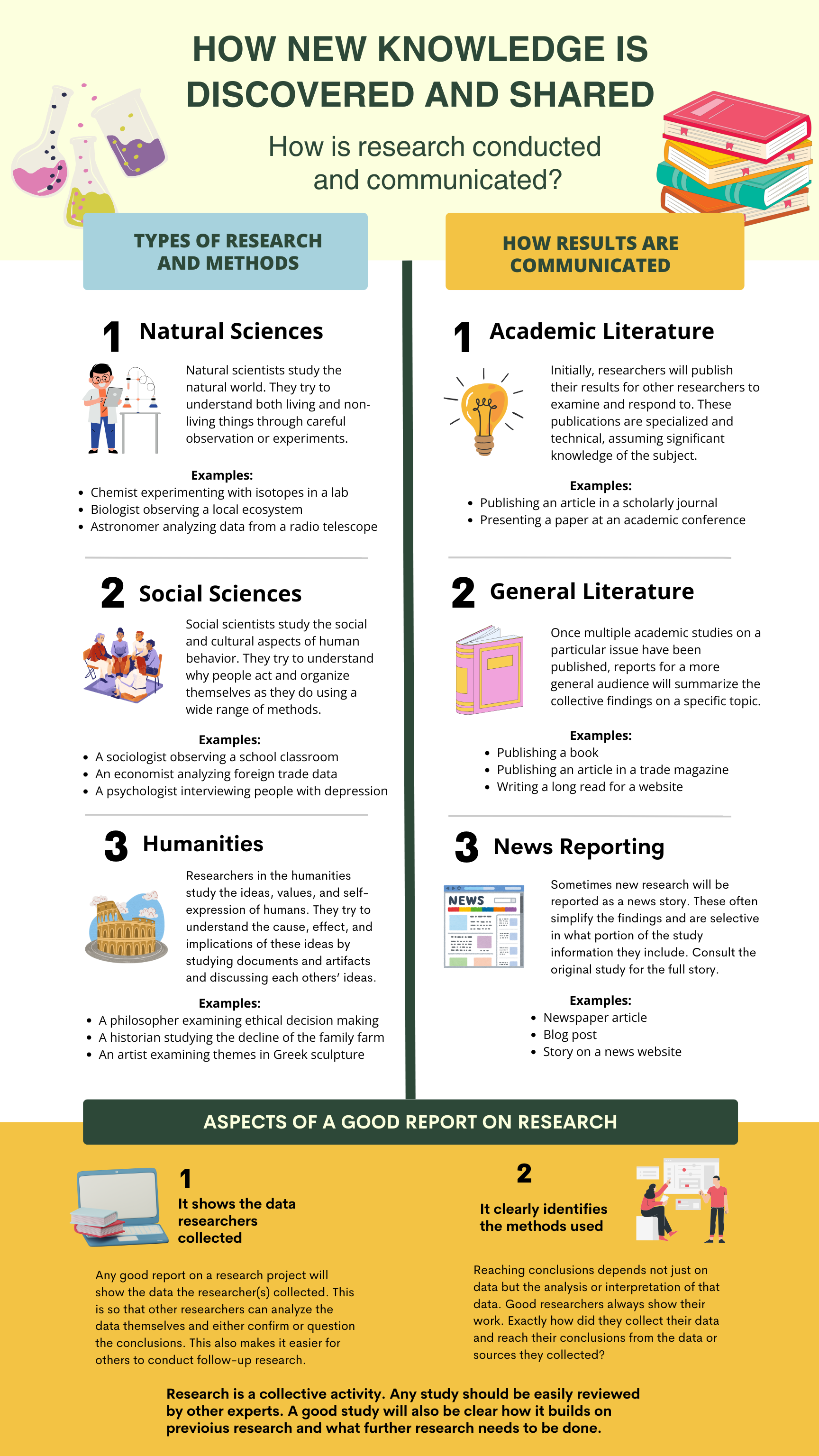6 Understanding How Researchers Discover New Knowledge
Brad Doerksen and Kaetlyn Phillips
Introduction
While we all encounter new information every day, we don’t always stop to think about how new knowledge is generated and then communicated to us. These resources are designed to help you give your students a basic understanding of the research and publication process that stands behind the generation of new knowledge. Not all knowledge is generated through the formal research methods described here, as we all learn things through our everyday experiences as well. However, a basic understanding of the kinds of research done in the natural sciences, social sciences, and humanities can help your students do a better job of searching for, evaluating, and making use of information sources in both school work and their personal lives.
Educator Resources
This infographic outlines the kinds of research scholars in various fields engage in and how they are communicated to others. Feel free to work through the infographic with your students yourself or show the following video where we use the infographic as a starting point to exploring these processes before discussing with your students as appropriate to your class.

Video Runtime: 5:15
Sample Lesson:
In this lesson we will demonstrate how research information is communicated, or miscommunicated by having students reverse engineer a “scientific claim” they find on social media back to the original source. We use an example regarding skincare, but if you have examples more relevant to your classroom’s interests, we encourage you to adjust the lesson accordingly. There are several fantastic debunking content creators, such as Ann Reardon, who look at online claims and find the actual research.
Target Audience: Grade 12
Possible Assignments: These activities can be a stand alone lesson, paired with the “Evaluating Online Sources” lesson, or used as a primer for any research or inquiry based assignment.
Learning Outcomes: CC A30.4
Lesson Objectives:
- Students will be able to trace and identify the research source for a topic
- Students will compare the different types of research practices for different subjects
- Students will identify how information can be altered depending on audience and medium
Lesson Outline (50 minute lesson):
Activity
- Show the class a short video making a scientific claim. For the purposes of this demo we are using: https://www.instagram.com/reel/DIUq62mTYnE/
- Discussion:
- Do you think the claim is true? Why or why not?
- How can we find out if the claim is true or not?
- Does the claim seem suspicious? Are there any red flags for the content? What are they
- Note: If you’ve covered the CRAAP assessment, this is an excellent time to review it!
- Have students try searching for the claim “60% of what’s on your skin is absorbed by the body into the bloodstream” (note: in some cases you may need to drop the “into the bloodstream” part as some search engines and social media search engines will censor terms referring to blood.
- What answers are found? Hopefully the debunking content shows up first!
- Discussion:
- Do you think there’s any actual science to this claim? Why or why not?
- How would we possibly find the answer?
- Show the video “Does 60% of skincare really absorb into blood?” from content creator Lab Muffin Beauty Science: https://www.youtube.com/watch?v=xxT4YHSl-YI Discuss:
- How do we know this content creator has done good research?
- Do they list their sources anywhere? (Hint! If you look in the description of the video there is a link to the more detailed blog post)
- Could we find the science they are referring to in the video?
- Go to Lab Muffin Beauty Science’s blog post: https://labmuffin.com/the-60-of-products-absorb-into-your-bloodstream-myth/
- Are there references to research that we can access?
- Was this process easy? Did the information stay consist as we moved from short form content to more detailed written content?
- What problems may occur with how information is shared through various types of media?
- Use either the infographic or the teacher resource video to explain how research is collected and disseminated to everyday people. Discuss and assess as you see fit.
Activity:
- Have student find their own short form content and attempt to find their way back to the source science. Note: They may not actually find any research at all! Make sure students document this. Discuss and assess as you see fit.

